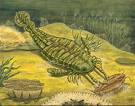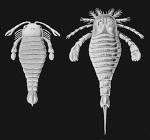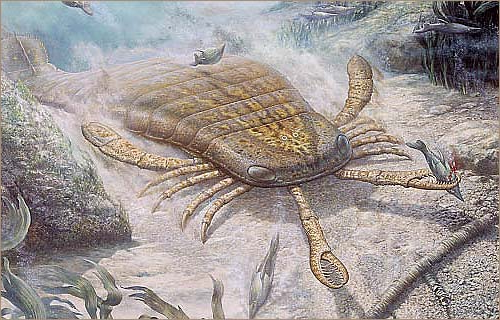Silurian Period 478 Million Years Ago
During the Silurian Period as the Earth's climate became warmer and more stable, animal life recovered in the seas. Sea levels rose, creating shallow seas that triggered a surge in animal evolution. On land also important changes are taking place. The first true plants appeared. By the time the Silurian Period ended, after 30 million years, land based animals were widespread, although few were more than an inch long.
 The
fight for survival has filled the seas with a variety of animals, but
only the adaptable have prevailed.This new world was terrorized by a new
and improved generation of armored arthropods.
The
fight for survival has filled the seas with a variety of animals, but
only the adaptable have prevailed.This new world was terrorized by a new
and improved generation of armored arthropods.  Brontoscorpio
appears, they resembled the modern scorpions, but these were 3 feet long
and have gills. They had a stinger the size of your fist. Scorpions are
the top predators in these waters. And their prey is plentiful in their
hutting grounds.
Brontoscorpio
appears, they resembled the modern scorpions, but these were 3 feet long
and have gills. They had a stinger the size of your fist. Scorpions are
the top predators in these waters. And their prey is plentiful in their
hutting grounds.
Brontoscorpio was not king during the Silurian Period, Pterygotus was [image on the right] . Pterygotus is the biggest arthropod of all time. More than ten feet long, it was the size of a modern crocodile. Pterygotus was an accomplished swimmer and could move with speed and agility through the water.
It would swim by flapping its long, flat tail up and down; the broad, flat part at the end would push it through the water in much the same way as the fluke on the whale's tail does. It would steer and stabilize itself using its legs.
 Cephalaspis was abundant during the Silurian. Like its immediate ancestors,
Cephalaspis was heavily armored, presumably to defend against these predatory
opponents.
Cephalaspis was abundant during the Silurian. Like its immediate ancestors,
Cephalaspis was heavily armored, presumably to defend against these predatory
opponents.
It had sensory patches along the rim and center of its head shield, which were used to sense for worms and other burrowing organisms in the mud. During breeding season, Cephalaspis traveled to fresh water, inland, out of scorpion's grasp. Cephalaspis brain was well protected by their thick skulls and was more developed than their rivals, the scorpions. This brain had a way of storing experience, memory. Which would allow them to return to the same breeding grounds.
It would be the arthropods and not the fish ancestors, that will take their first steps out of the sea, onto dry land. Brontoscorpio had gills that could be used as simple lungs when outside the water. They were made up of hundreds of thin layers of tissue. It couldn't breathe like mammals do, but rather absorbed the oxygen directly and passively into its system. Brontoscorpio being protected by its armor against sunlight and the elements, and having developed a system to breathe, would have been able to patrol shoreline, scavenging on whatever washes up.
